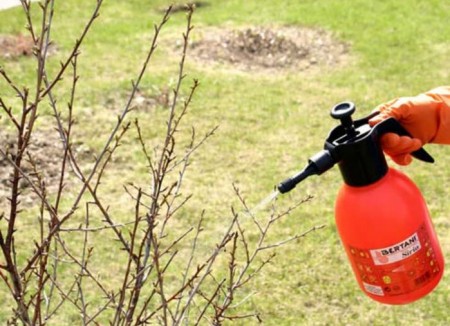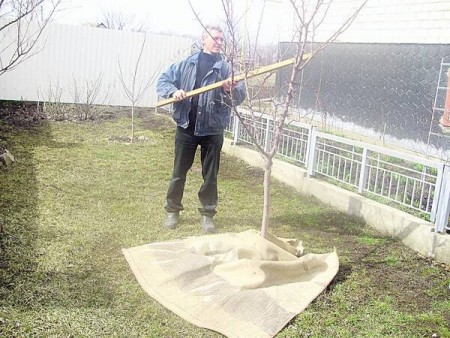- The fight against diseases and pests should begin in early spring.
- What folk remedies can be used to kill harmful insects?
- What chemicals are best to use?
- How to protect your garden from diseases?
You will find answers to all these and many other questions in this article.
In the spring, before gardens bloom, pests of fruit trees and berry bushes begin to work more actively.On apple and pear trees these are aphids, psyllids, sawflies, leaf-eating caterpillars, and mites. On plums and cherries there are plum sawflies, cherry weevils, leaf-eating mites, shoot moths, flower beetles and other pests. We must immediately begin the fight against them.
Folk remedies for pest control
Those who often go to the country in the spring can use a simple but effective method in cloudy weather to combat many pests - shaking off pests onto the litter three times, with an interval of 3-4 days, if the air temperature is above 10 degrees.
From pests living in the soil (sawflies, moths, glass beetles, beetle larvae), it is recommended to cover the soil under trees and shrubs with roofing felt, film, or rebroid. Their edges need to be covered with earth. Pests will not be able to get out from under their shelters and will die. Covers are removed at the beginning of flowering, because at this time beneficial insects emerge from the soil.
Treating the garden with chemicals
Of the chemical insecticides allowed, alatar, fufanon, kemifos, spark - 10 ml per 10 liters of water, kinmiks (2.5 ml), actellik (15 ml). Any of them can be used.
Lately, pear worm has spread in gardens. It begins to cause harm at the beginning of flowering and continues throughout the summer because it produces 4 generations.
To combat it during the budding phase, fufanon is used - 2 treatments with an interval of 20 days. Add 40 g of laundry soap to the solution.
How to deal with garden diseases
In spring, the first signs of fungal diseases appear (scab, powdery mildew, fruit rot, leaf spot, coccomycosis, clusterosporiasis).
If at the beginning of April you did not “blue spray” with a 3% Bordeaux mixture, now you can treat varieties that are not resistant to diseases with a 1% Bordeaux mixture or the drug abigapic or rayek (1.5-2 ml per 10 liters of water), or strobi (2 g).
A good remedy for preventing diseases and strengthening the immunity of plants is the drug Healthy Garden or its substitute - zircon + epin-extra.
Many gardeners use phytosporin in the spring to spray young leaves under trees and shrubs. A plate of phytosporin (200 g) is diluted in 400 ml of water and placed in a cool place.
To prepare the working solution, take 1 tbsp. spoon per 10 liters of water, you can add potassium humate (15 ml). The working solution is used immediately.
To prevent moniliosis and coccomycosis in the spring, during the period of leaf unfurling, trees can be treated with a mixture of zircon (4 drops) and ferovit (2 drops per 1 liter of water). Repeated treatment - after 15 days.
Cherries affected by coccomycosis or clusterosporium last year must be treated with copper-containing preparations: 1% Bordeaux mixture or abiga-pic. If this is not done, after 2-3 seasons the trees may die completely.
- First treatment - before flowering of stone fruits
- Second treatment - immediately after flowering
- The third - 2-3 weeks after flowering.
After flowering, you can replace copper-containing preparations with colloidal sulfur (100 g per 10 liters of water) mixed with iron sulfate.
Copper-containing preparations can leave stains on leaves (especially cherries). Therefore, they should be sprayed early in the morning or in the evening, or even better - in cloudy weather.
Stone fruit trees benefit from root feeding in the spring, consisting of 2 tbsp. spoons of urea, 1 tbsp.spoons of potassium sulfate and a liter jar of wood ash per 10 liters of water. They bring it along the perimeter of the crown.
How to spray berry bushes
To treat berry bushes before flowering, use Actellik (15 ml per 10 liters of water). Raspberries are sprayed with 1% Bordeaux mixture or abiga-pik against anthracnose and purple spot.
Actinidia, Schisandra chinensis, honeysuckle are treated with abiga-pik or a 1% Bordeaux mixture before flowering and immediately after it.
During the entire growing season, cut out and burn ugly, underdeveloped, drying out shoots of currants and gooseberries that are infested with currant glass.
For raspberries, cut out wilting stems, those with thickenings, damaged by raspberry gall midge, raspberry stem fly and those suffering from anthracnose and purple spot.
How to treat strawberries
Strawberry plantation Before flowering, treat against diseases and pests with 1% Bordeaux mixture at the beginning of leaf regrowth, and during the formation of buds with Actellik or Fufanon.
- Two weeks before flowering, apply complete mineral fertilizer. To protect strawberries from contamination and rotting, lay straw (but not cutting) or spunbond along the rows.
- For leaf spots and gray rot on fruiting strawberries before flowering, you can spray with a copper-soap emulsion (200 g of soap + 20 g of copper sulfate per 10 liters of water).
- Feed bare strawberries with nitrogen fertilizers (1 tablespoon per 10 liters of water) in the row spaces.
- Good results are obtained by spraying strawberries with the biostimulant Novosil (3 ml per 10 liters of water).
- To get early strawberries, place arched (on arcs) film shelters over them.
Rake and burn old leaves from last year.After this, water the strawberry bushes with a bright pink solution of potassium permanganate, but without adding boric acid; strawberries do not tolerate boron and copper.
You might be interested in:
- How to get rid of weeds
- Biological products to protect the garden from pests
- Summer resident calendar, seasonal work at the summer cottage



 CUCUMBERS NEVER GET SICK, I'VE BEEN USING ONLY THIS FOR 40 YEARS! I SHARE A SECRET WITH YOU, CUCUMBERS ARE LIKE THE PICTURE!
CUCUMBERS NEVER GET SICK, I'VE BEEN USING ONLY THIS FOR 40 YEARS! I SHARE A SECRET WITH YOU, CUCUMBERS ARE LIKE THE PICTURE! You can dig a bucket of potatoes from each bush. Do you think these are fairy tales? Watch the video
You can dig a bucket of potatoes from each bush. Do you think these are fairy tales? Watch the video
 How our fellow gardeners work in Korea. There is a lot to learn and just fun to watch.
How our fellow gardeners work in Korea. There is a lot to learn and just fun to watch. Eye trainer. The author claims that with daily viewing, vision is restored. They don't charge money for views.
Eye trainer. The author claims that with daily viewing, vision is restored. They don't charge money for views. A 3-ingredient cake recipe in 30 minutes is better than Napoleon. Simple and very tasty.
A 3-ingredient cake recipe in 30 minutes is better than Napoleon. Simple and very tasty. Therapeutic exercises for cervical osteochondrosis. A complete set of exercises.
Therapeutic exercises for cervical osteochondrosis. A complete set of exercises. Which indoor plants match your zodiac sign?
Which indoor plants match your zodiac sign? What about them? Excursion to German dachas.
What about them? Excursion to German dachas.